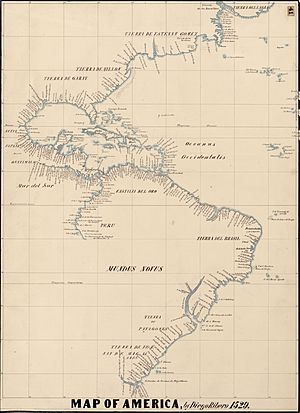Estêvão Gomes facts for kids
Estêvão Gomes, also known as Esteban Gómez, was a Portuguese mapmaker and explorer. He was born around 1483 and died in 1538. He sailed for Spain and was part of Ferdinand Magellan's famous trip around the world. However, he left that journey early. Later, in 1524, he explored parts of what is now Nova Scotia in Canada. He might have even sailed into New York Harbor and seen the Hudson River. His travels helped create much more accurate maps of the East Coast of North America.

Contents
About Estêvão Gomes
Estêvão Gomes was likely born in Porto, Portugal. When he was young, he sailed to India on Portuguese ships. In 1518, he moved to Spain. There, he became a pilot for the Casa de Contratación in Seville. This was a special government agency that controlled Spain's trade and exploration with other parts of the world.
Magellan's Expedition
In 1519, Gomes joined Magellan's expedition. This was the first trip to sail all the way around the Earth. Gomes was the pilot of a ship called the San Antonio. When the ships reached the Strait of Magellan, Gomes and some other men on his ship decided to return to Spain early. They arrived back in May 1521.
When he first returned, Gomes was put in jail. But then, the only remaining ship from Magellan's journey arrived in Spain in September 1522. The crew told their difficult story. After hearing this, Gomes was set free.
Searching for a Northern Passage
Gomes was able to convince Emperor Charles V to pay for a new trip. The goal was to find a northern sea route to the Maluku Islands, also known as the Spice Islands. This famous route was called the Northwest Passage. A 50-ton ship, La Anunciada, was built for this journey.
The expedition started on September 24, 1524, from A Coruña, Spain. There were 29 men on the crew. Gomes first sailed to Cuba and then headed north.
Exploring North America
There are no written records of Gomes's exact path, only a map. So, people disagree about where he went. Gomes might have sailed as far east as Cape Breton Island in Canada. He also entered Upper New York Bay and the Hudson River. He named the Hudson River the "San Antonio River."
It is debated whether he explored from north to south or from south to north. Either way, he passed through Maine. There, he thought the mouth of the Penobscot River might be the Northwest Passage.
Gomes returned to Spain on August 21, 1525. During his trip, Gomes brought back over 50 native people to Spain. He hoped to show that a profitable trade in people could be started. However, Emperor Charles V was reportedly very upset by this. He ordered that the people be set free.
Lasting Impact
Because of Gomes's expedition, the 1529 Diogo Ribeiro world map shows the east coast of North America almost perfectly. For a long time, the northern part of the current US coast was named Tierra de Esteban Gómez (Land of Esteban Gómez) on maps.
In 1535, Gomes joined another expedition led by Pedro de Mendoza. This trip went to the Río de la Plata in South America. During this journey, Gomes was killed by native people in the Paraguay River in 1538.
See also
 In Spanish: Esteban Gómez para niños
In Spanish: Esteban Gómez para niños

